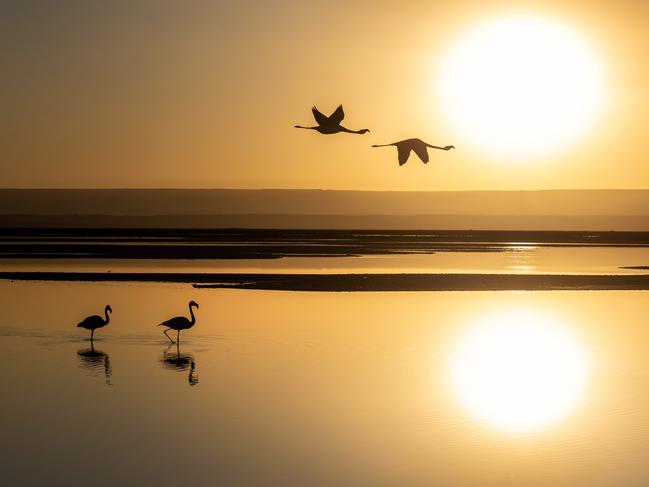Flamingoes, roadrunners and moonscapes: this next-level destination is out of this world
San Pedro de Atacama is a Chilean oasis - a place of stunning simplicity and an almost total absence of rain.

The driest (non polar) place on Earth is a profusion of sand and rocks. With its moonscapes and blackened dunes, a soaring Andean backdrop and smattering of salt lagoons, it’s a geologist’s fantasy and home to countless flamingos and road runners. But that’s only partly why we’ve decided to extend our stay.
San Pedro de Atacama is an oasis in Chile’s Atacama Desert. It’s a place of stunning simplicity with its mudbrick buildings and an almost total absence of rain, the nearby Andes mountains proving an effective barrier against any wayward clouds.
In 21st-century Chile, it’s a standout destination, not only because it seems to have sidestepped the political instability still resonating through the country after the anti-government protests that began in 2019. In this long, thin land that skirts the southern Pacific Ocean, it’s also a rare non-coastal destination. Two-hour flights from the capital, Santiago, land at Calama airport, from where shuttle buses make the 100km journey to town.

While the aerial approach to Calama is enticing, the drive towards San Pedro de Atacama initially seems anything but. From Calama’s airport, the treeless terrain is strewn with rubbish for kilometres. Then, as we leave the city’s outskirts, every few minutes we pass another of the roadside shrines known as animitas that honour road fatalities. Colourful and often ornate, they’re a striking contrast to the landscape, a monotone of fawn, a backdrop so stark that even an hour into the journey we wonder what could possibly lie at the end of this desert route that has enthused so many.
Suddenly, just minutes before our expected arrival, our driver pulls off the road and announces we are stopping briefly for some scenic shots of our destination. The view that unfolds from the lookout is confirmation that we are headed someplace special. Ahead of us, San Pedro de Atacama is a patch of green rising from the dust, its single-storey mudbrick buildings lending a wild west feel to a town that, up close, feels both exotic and charming.
With its gaggles of wandering tourists and buskers crooning local folk songs, it is hot and, at 2500m above sea level, reasonably high, and after a month exploring the continent it also comes closest to how we imagined South America.

Its tiny main street, open to pedestrians only, is an unpaved patch that is festooned with fairy lights and lined with simple structures whose interiors, at first, seem a mystery. Only when their shutters are opened do they reveal the plethora of enterprises, from computer shops to travel agencies and upmarket gift outlets, that thrive on the passing tourist trade.

In much the same way, the surrounding region, with its monotones of colour, reveal a cornucopia of eye-boggling moments. With exploration of the area largely limited to tour buses or private car hire, in the days that follow we discover a region rich in natural wonders. There are geysers and flocks of flamingos, lofty sand dunes, and lagoons salty enough to float in. One day we explore the lunar-like Valley of the Moon before heading to sunset drinks overlooking the Andes. One night we join an astronomy tour and explore the enormous night sky in a region renowned for its stargazing.
Back at our hotel we fall asleep to silence, and awake to bird song. And when our stay comes to an end, we extend it a little longer. It’s that hard to leave.
Checklist
Getting there: Airlines including LATAM fly multiple times a day between Santiago and Calama. San Pedro de Atacama is an 80-minute drive from Calama airport. Several shuttle companies, including Transfer Pampa, service this route. latamairlines.com; transferpampa.cl
How to explore: Like children, it’s hard to pick a favourite among the many (but seemingly similar) tours that the countless travel agencies around town offer. Because of the heights involved, it’s preferable to opt for lower-altitude tours earlier in your stay, leaving, say, a visit to the Tatio Geysers (4300m above sea level) until as late as possible so your body has time to acclimatise.
Eat: In a continent that’s so keen on meat, setting up a vegetarian restaurant in the middle of San Pedro de Atacama might seem risky. But it’s testament to the floods of travellers passing through town that tiny Estrella Negra seems even more popular than the meat-laden restaurant to which it’s attached. Sitting at the far end of Caracoles Street, its menu includes some tasty riffs on local dishes. Standouts include a mushroom ceviche, and a vegetarian version of the Chilean corn and beef favourite pastel de choclo.
Stay: Set on one of the town’s few paved roads, the very welcoming Hotel La Casa De Don Tomas is also well located: far enough away from the centre of town to avoid the occasional round of raucous singing, but close enough so that, even for those new arrivals walking gingerly while becoming accustomed to the altitude, it’s still less than a 10-minute walk to restaurants and shops. While a newer branch (branded as the “refugio”) is pitched as more upmarket, the original hotel complex is closer to town and feels like a more spacious property. Like many places in the area, there are no air conditioners, TVs or mini bars. But the simplicity of the pristine rooms is matched by a generous breakfast spread best enjoyed on the expansive terrace and by any number of shaded sitting nooks dotted around the quiet property. Rates are from about $A180 per night. dontomas.cl

